
The melon barb is a common species of cyprinid fish that is endemic to rivers in Goa, Karnataka, Kerala and Tamil Nadu in the Western Ghats of South India. They live in a tropical climate in water that typically has a pH of 6.0—6.5, a water hardness of around 5 dGH, and a temperature range of 22–26 °C (72–79 °F). This species can also be found in the aquarium trade.

The banded kōkopu is a galaxiid of the genus Galaxias, found only in New Zealand, including the Chatham and Stewart/Rakiura islands. It commonly grows to 20–25 cm, but has been recorded growing to around 30 cm. Juvenile banded kōkopu are good climbers and can climb up waterfalls and other vertical surfaces by moving into the splash zone and wriggling up the surface, using the water surface tension and their large downturned fins for grip.

The banded sand catshark is a catshark of the family Scyliorhinidae found in the Indo-West Pacific Ocean, endemic to northern Australia between latitudes 10° S and 21° S, at depths between 27 and 120 metres. Its length is up to 45 centimetres (18 in). They were the first sharks to be discovered living in sponges.

The striped smooth-hound is a houndshark of the family Triakidae, found on the continental shelves of the subtropical southwest Atlantic from southern Brazil to northern Argentina between latitudes 30° S and 47° S, from the surface to 250 m. It can grow up to a length of 1.77 m. The reproduction of this shark is Ovoviviparous, with the length at birth up to 39 cm.
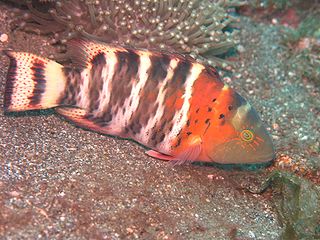
The red-breasted wrasse is a species of wrasse native to the Indian Ocean and the western Pacific Ocean.

The blacktip grouper, also known as the redbanded grouper, blacktipped cod, black-tipped rockcod, footballer cod, red-barred cod, red-barred rockcod, scarlet rock-cod or weathered rock-cod, is a species of marine ray-finned fish, a grouper from the subfamily Epinephelinae which is part of the family Serranidae, which also includes the anthias and sea basses. It is found in the tropical Indo-Pacific region. It is the type species of the genus Epinephelus.
Leptomantis fasciatus is a species of frog in the family Rhacophoridae found in Malaysia, Indonesia, and Brunei. It has been observed as high as 200 meters above sea level..

The Mediterranean killifish, Mediterranean banded killifish or South European toothcarp is a species of fish in the family Cyprinodontidae. It is found in Albania, Algeria, Bosnia and Herzegovina, Croatia, Cyprus, Egypt, France, Greece, Israel, Italy, Lebanon, Libya, Malta, Morocco, Montenegro, Slovenia, Syria, Tunisia, and Turkey. Its natural habitats are saline lakes, saline marshes, and coastal saline lagoons.

Neolamprologus fasciatus is a species of cichlid endemic to Lake Tanganyika. This species spawns in empty snail shells. This species can reach a length of 15 centimetres (5.9 in) TL. This species can also be found in the aquarium trade. They are piscivores and their prey includes the cichlid fish Variabilichromis moorii.

Salarias fasciatus, commonly known as the jewelled blenny or lawnmower blenny is a benthic, neritic, marine fish species endemic to Australasia. Despite being known as the lawnmower blenny, due to its propensity to consume algae growth in aquaria, it is principally a detritivore, with plant material making up only about 15% of its diet. The lawnmower blenny camoflauges with its surroundings, even changing color to hide itself from predators.
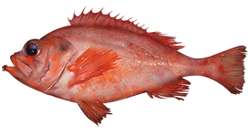
The Acadian redfish, also known as the Atlantic redfish, Acadian rockfish, or Labrador redfish, is a species of marine ray-finned fish belonging to the subfamily Sebastinae, the rockfishes, part of the family Scorpaenidae. It is native to the deep waters of the northwestern Atlantic.
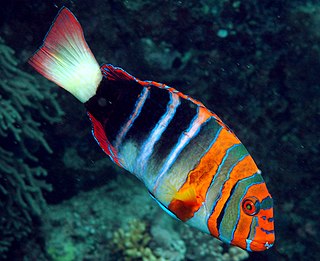
The harlequin tuskfish, Choerodon fasciatus, is a species of wrasse native to the western Pacific Ocean. It occasionally makes its way into the aquarium trade.
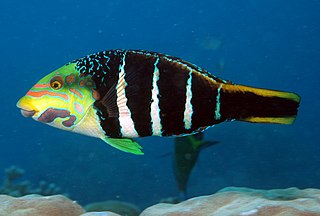
The barred thicklip wrasse is a species of fish belonging to the wrasse family, native from the Indo-Pacific.

Noturus fasciatus is a rare freshwater fish native to the U.S. state of Tennessee. It was first described as a species separate from Noturus crypticus in 2005. It is restricted to the Duck River system and is also found in two minor tributaries on the lower section of the Tennessee River. This species dwells in small to medium-sized streams where they can be found under gravel, rubble, and slab rock. They feed mostly on insects such as: stone, cattus and mayfly larvae.
Parazacco is a genus of small freshwater fish in the family Cyprinidae, native to China and Vietnam.

The Transcaucasian spirlin is a fish species in the family Cyprinidae. It is widespread in the Western Transcaucasia and rivers of the Black Sea coast in Turkey westward to the Kızılırmak River. It prefers rivers and streams with fast-running shallow water over gravel, pebbles, or rocks.
Parazacco spilurus, also known as the Predaceous chub, is a species of fish in the family Cyprinidae distributes in the Pearl River system, the Hainan Island and northern Vietnam.
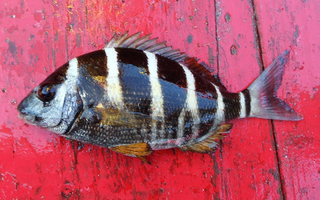
The banded seabream is a species of marine ray-finned fish belonging to the family Sparidae, which includes the seabreams and porgies. This species is endemic to Cape Verde in the eastern Atlantic Ocean.

Limnichthys fasciatus, the barred sand burrower, is a species of sandburrower. It is noted for its highly developed eyes, with a structure similar to the eyes of a chameleon, which has led it to be described as marine chameleon. Its fully grown length measures between 20 millimetres (0.79 in) and 40 millimetres (1.6 in). The species is native to reefs in the Indo-Pacific. The fish preys on plankton prey by surprise attacking it from a hiding in loose sand, with only the eyes protruding from the sand.
















